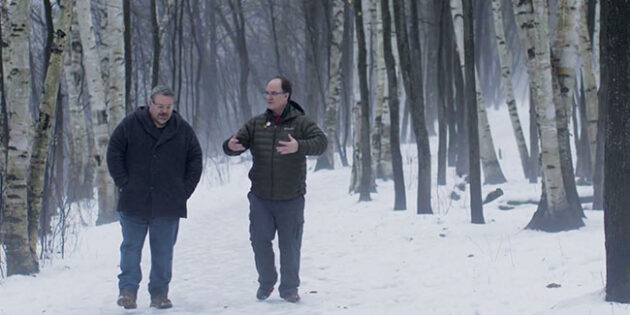
Features
The value of collaboration
Unique partnership towards sustainable forest management
May 5, 2023 By David Flood and Chris McDonell
 There is an increasing dependence on forests for wood fibre as demand rises worldwide, requiring a healthy balance between industry, conservation and Indigenous rights. Photo: Annex Business Media.
There is an increasing dependence on forests for wood fibre as demand rises worldwide, requiring a healthy balance between industry, conservation and Indigenous rights. Photo: Annex Business Media. Nearly 1.7 million people in Canada identify as First Nations, Metis and Inuit. They live in over 600 communities across the country, and the vast majority depend on forests for food sovereignty and security, medicines, clean water, and spirituality.
At the same time, there is an increasing dependence on forests for wood fibre as demand rises worldwide, requiring a healthy balance between industry, conservation and Indigenous rights. While challenging, this balance is very much achievable – and one example can be found in the boreal forests near Chapleau, Ont., east of Lake Superior.
There we find Wahkohtowin Development, an Indigenous-led social enterprise rooted in sustainable forestry that serves its three First Nations owners: Brunswick House, Chapleau Cree, and Missanabie Cree. It pursues its mission with the respect and collaboration of GreenFirst Forest Products, a local forest products company committed to sustainable forestry.
This strong relationship is built on trust, in part owing to the fact that GreenFirst has held Forest Stewardship Council (FSC) certification for nearly 20 years – thus committing to upholding Indigenous rights. The FSC standard has proven to be a tool by which GreenFirst has deepened its relationship with Wahkohtowin, allowing them to better understand First Nations perspectives and goals, and reconcile their practices with Indigenous interests in mind.
This partnership has shown demonstrable impact, with both Indigenous and non-Indigenous industry perspectives integrated into a shared goal of sustainable forest management. GreenFirst and Wahkohtowin have worked together to safeguard the conservation of land for important cultural purposes, including birch syrup production and moose habitat protection.
As part of the Wahkohtowin Guardian program, Indigenous youth have also been engaged to survey and assess the land in a joint effort to improve forest renewal – participants whose feedback and ideas in turn grant GreenFirst unique perspectives on the land it harvests.
Supporting free, prior and informed consent
It is commonplace today for forestry companies to have policies in place about how they must work with nearby Indigenous communities. Still, it is requirements, such as those found in the FSC standard’s Principle 3, that help create lasting engagement and meaningful relationships.
This engagement is enshrined with FSC’s commitment to free, prior and informed consent (FPIC), a right that pertains to Indigenous Peoples, now recognised in the United Nations Declaration on the Rights of Indigenous Peoples (UNDRIP).
FSC requires all certified forest owners or managers to uphold its principles in order to earn and maintain certification. Through this, each Indigenous community grants, withholds or withdraws its consent on projects and activities that impact their rights – in accordance with UNDRIP and the International Labour Organization’s Convention 169.
By implementing UNDRIP and FPIC into the new national forest stewardship standard both globally and domestically, FSC not only opens the door for economic opportunities and participation from communities, but also drives ecosystem resiliency by holding industry players accountable for taking action. Indeed, when consumers see the FSC logo, they know they are supporting a company that doesn’t just follow the status quo, but pursues a sustainable global model for how forestry should be.

(L-R): David Flood and Chris McDonell. GreenFirst and Wahkohtowin have worked together to safeguard the conservation of land for important cultural purposes. Photo courtesy of FSC. Canada.
A symbiotic approach
For GreenFirst, it took time and commitment to work in step with Wahkohtowin to achieve a symbiotic approach to sustainable forestry. And the results speak for themselves: economic benefits, cultural revitalization, community growth, and with effective conservation and monitoring, the chance to leave a legacy of healthy forests for future generations.
Kevin Tangie (Big Knife), the lands and resources economic development portfolio holder for Brunswick First Nation, shares his perspective on Wahkohtowin-industry partnerships and what he has seen play out over the past several years.
“The main thing for our people is to have protections in place, and the ability to regain some control and oversight on our lands and the activity that is happening out in the field,” Tangie says.
“Wahkohtowin is helping us obtain more sovereignty in terms of our influence on these lands, including forestry, developers, resources, extractions, and a number of environmental factors. Along with our First Nations partners, we are better able to align our forestry management techniques and become active partners in resource development projects.”
Many Indigenous Peoples hold close the Seventh Generation Principle – that today’s decisions must lead to a sustainable world seven generations from now. Those decisions are best made jointly by all stewards of the forests, which can be described in policy, but which need decisive action and trusted partnerships – like that seen with Wahkohtowin and GreenFirst – to achieve lasting positive impact.
David Flood (Strong Wolf) is a member of the Ojibwe Nation, and the general manager of Wahkohtowin Development.
Chris McDonell is chief forester for Ontario at GreenFirst Forest Products.
Print this page